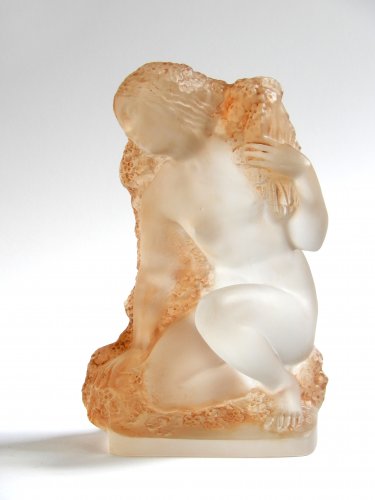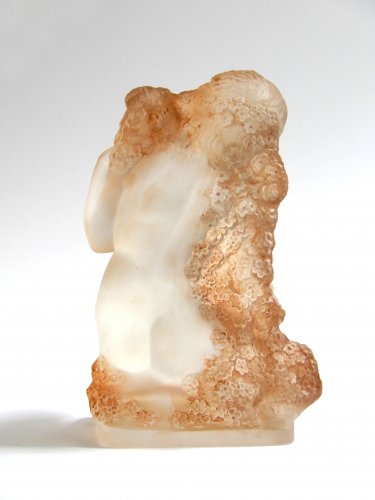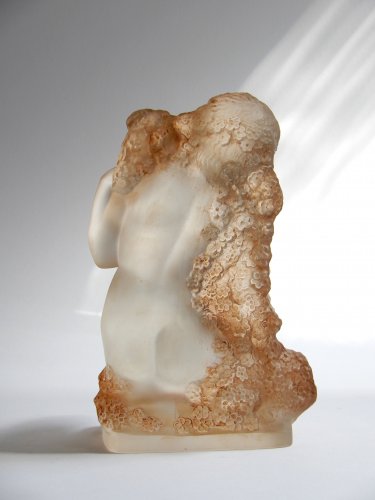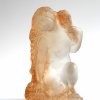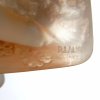René Lalique (1860-1945) 'Printemps'
About this piece
René Lalique made a series of four godesses in 1939 that together represent the four seasons. This sculpture is representing 'Spring' (Printemps), Spring is often synonymous with fertility, prosperity and expectation. Its official title is "Printemps" surtout Quatre Saisons.
The sculpture is made of clear frosted glass and pressed in the mould. Made during the lifetime of René Lalique produced under model number 839 Bis. After 1947, Maison Lalique recreate this sculpture again under a different model number and signature.
The work is signed on the bottom with a stenciled signature "R. Lalique, France".
Literature:
- Félix Marcilhac, ‘R. Lalique, Catalogue raisonné de l’oeuvre de verre’, Les Éditions de l’Amateur, Paris 2011, p. 402, modelnummer 839 Bis.
- Christopher Vane Percy; 'The glass of Lalique, a collectors guide', Studio Vista, Cassell & Collier Macmillan Publishers Ltd, London, 1977. P. 148.
- Philippe Olland; 'Dictionnaire des Maîtres Verriers de l'Art Nouveau á l'Art Déco, Marques & signatures'. Éditions Faton 2016. P. 192-199.
Biography:
René Lalique (1860-1945) was active as an apprentice jeweller at age 16. After been 2 years in England as an apprentice, he started his own business ,in 1880, as a jewellery designer. He soon became a success, especially after he participated at the Universal Exhibition of 1900 in Paris. Thereafter his name was definitively established.
From 1890 he was also very interested in glass. He adapted glass in his designs. He soon expanded his work with the proper tools and equipment, and also increased his knowledge, especially in the field of colouring and moulds. In 1905 he received orders from François Coty to design various perfume bottles, he experimented with new styles and techniques. During that time he started to work with moulds and pressed glass. In 1912 he started his second career as a master glass artist. He once said that he would create something so special that's not been seen before. Which he certainly succeeded.
He then made except small glass objects such as jewellery and perfume bottles, major works as vases, lamps, tableware, clocks, car mascots, but also architectural glass applications such as door handles, wall panels etc.
After WWI, the French government offered him for not much money a factory in the Alsace, the Alsace was French again. He built a new glass factory in Wingen-sur-Moder where he produced most of his pressed glass vases. Mid 1930's he closed his factory in Paris and everything was produced in Wingen-sur-Moder, till now. After his death in 1945, his family continued the company.
He is seen as one of the largest glass artists in the world. His work is admired worldwide in museums, there are also several museums that are only dedicated to René Lalique, such as Lalique Museum Doesburg in the Netherlands and of course Musée Lalique in Wingen-sur-Moder, France, but also in Hakone (Japan) and many other countries.
Condition
A few small airbubbles on the bottom and one on the body.
Material:
Glass
Measurements:
Height: 19,5 cm
(7,68")
Weight:
1.949 grams
(68,75oz)
Year:
Between 1939-1945
Period:
Between 1939-1945
Origin:
France
Artist / atelier:
René Lalique,


